Seasonic Platinum SS-1050XP3 & SS-1200XP3 Power Supply Review
by E. Fylladitakis on September 3, 2014 6:00 PM EST- Posted in
- Cases/Cooling/PSUs
- Seasonic
- 1200W
- 80Plus Platinum
- 1050W
Seasonic Platinum SS-1200XP3 Cold Test Results
This is a repeat (in case you skipped page three), but for the testing of PSUs, we use high precision electronic loads with a maximum power draw of 2700 Watts, a Rigol DS5042M 40 MHz oscilloscope, an Extech 380803 power analyzer, two high precision UNI-T UT-325 digital thermometers, an Extech HD600 SPL meter, a self-designed hotbox, and various other bits and parts. For a thorough explanation of our testing methodology and more details on our equipment, please refer to our How We Test PSUs - 2014 Pipeline post.
The energy conversion efficiency of the Seasonic Platinum SS-1200XP3 is, unexpectedly, noticeably better than that of its 1050W sibling. Once again, the maximum conversion efficiency manifests at 40% load (94.4%), with an average conversion efficiency within the nominal load range (20% to 100%) of 93.4%. From the chart, we can see that the Platinum SS-1200XP3 easily surpasses the 80 Plus Platinum efficiency requirements during our testing. At 10% load, the efficiency drop to 89.5% is very small, but at just 5% load it drops to 79.8%. Obviously using a 1200W PSU to drive a 60W load on a regular basis would be rather odd, so in most use cases the efficiency will be much higher.
Much like its less powerful sibling, the cooling profile of the Seasonic Platinum SS-1200XP3 is very aggressive, even with the fan set to hybrid mode. Even at room temperature, the fan starts at just 20% load. This time however, the Platinum SS-1200XP3 maintains very low noise levels up to 40% load, taking advantage of its very high efficiency. As the load increases above 50%, the speed of the fan increases radically, turning the silent 80 Plus Platinum certified unit into a hoover in no time at all. The operating temperature is very low, with the heatsinks hardly surpassing 55°C at maximum load, increasing the long-term reliability of the unit.


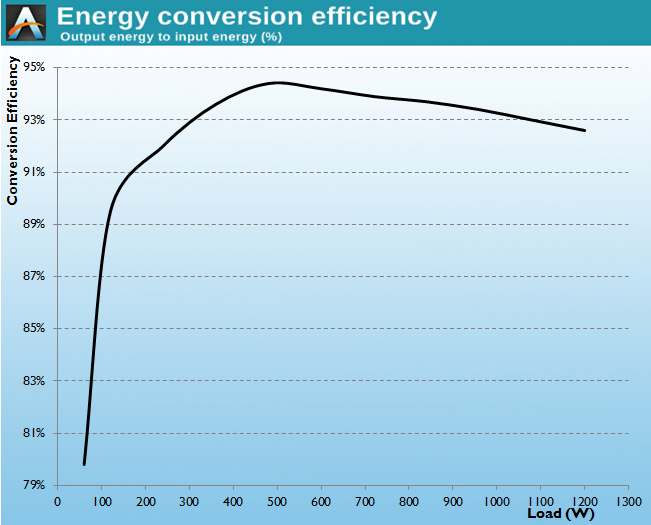
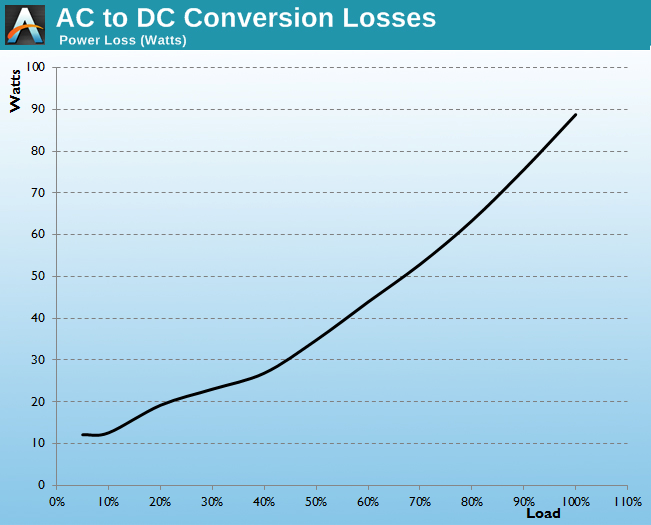
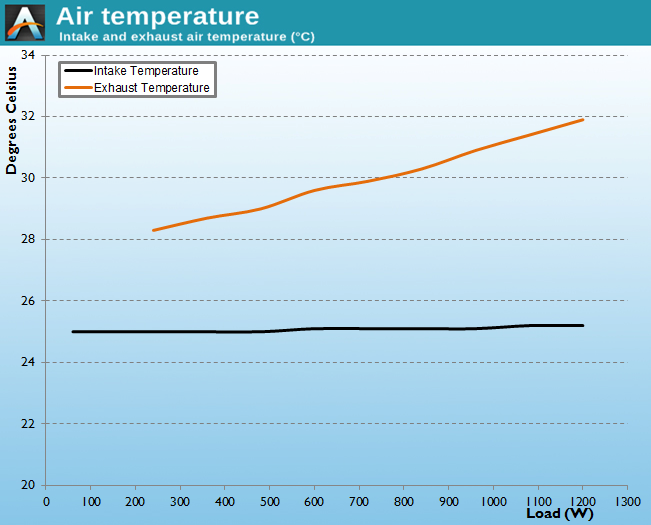
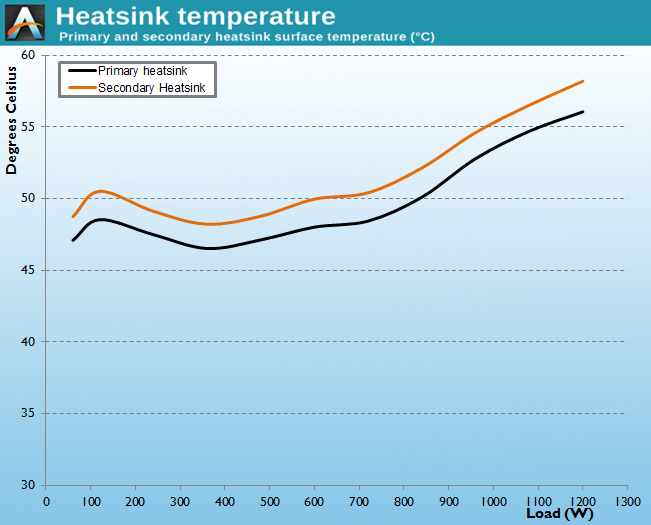
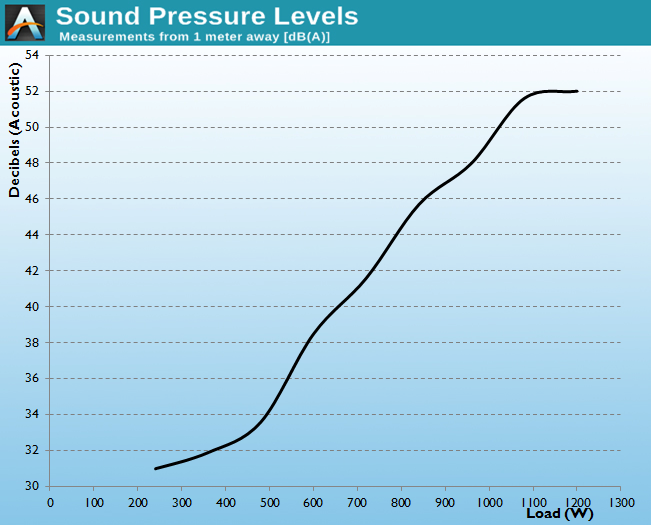








39 Comments
View All Comments
roncat - Thursday, September 4, 2014 - link
Why would you not just use a separate power supply just for the video card? Could you not just make the commons "common" for all PSU, and use the appropriate size for each application to be the most efficient. I assume the PSU outputs are fully floated. Anyone who knows why this may not work (ground loop hell, etc.), please reply.Phillip Wager - Monday, September 8, 2014 - link
this used to be an actual thing that people would do about 10 years ago when sli and crossfire just started coming out. back then everybody had full towers anyway that could house two PSUs the top one would be fore the system and drives and the bottom psu would be for your graphics card. back then 850-1000 watt power supplies were like $600 so getting two 350-500 watt power supplies was a more cost effective option. also cooler master and evga and a lot of brands made power supplies that just had 2-4 VGA eight pins coming off of it and it was marketed to gamers as video card power supplies and it was going to provide more stable power to your videocards and blah blah blah. Now the trend is to make everything SMALLER the majority of regular people who have home pcs their only home pc is actually a laptop or an all-in-one. The trend for gaming pcs is to make small game-console sized PCs and most full sized chasis these days dont even have the screw holes to fit a 2nd power supply on top of the motherboard anymore. and like i said in another post spending $70-150 to save at most 80 dollars of power over the life of the system is hardly worth the initial upfront cost especailly to deal with fitting another bulky heat source in your chasis.bebimbap - Thursday, September 4, 2014 - link
From an economical standpoint, "fixing" the lower efficiencies at almost no power draw is not worth your money. for example, and extra 15w of power 24/365 is only 131kwh most places in the us is about $.10 a kwh. why not just let it go to sleep, or shut off, most computers with ssds boot up to desktop in less than 30 seconds. But I digress, so continuing on, the inefficiency will cost you $13 more year for never using your computer. you have to subtract any time you are at non-idle state. but if you have that power supply for 8 years and not use the computer that entire time of course it adds up to $100 for keeping a computer idle 100% of the time 24/365. But if a psu was made to be 90% efficient at 10w AND 90% efficient at 1200w i guarantee you, you'd pay $200+ more per power supply for that efficiency or it'd be the size of 2 power supplies since you'd basically need 2. wasting 2x the money is also inefficient.Laststop311 - Wednesday, September 3, 2014 - link
230 is pretty expenive for the 1050 watt. I got the 80+ platinum 1000 watt seasonic for 185 45 more dollars for 50 watts is pretty crapIketh - Wednesday, September 3, 2014 - link
yea I was hoping to get a quick explanation of the differences between the 1050W and their 1000W, especially considering the price differenceIketh - Wednesday, September 3, 2014 - link
Nicely written article. The level of detail was superb.Freakie - Wednesday, September 3, 2014 - link
Dat voltage regulation though.I'm actually surprised the ripple was so high, usually Seasonic units completely beat every other unit in their class. But still, only PSU's I will put in my personal systems are Seasonic. Pretty legendary quality and performance.
SammichPG - Thursday, September 4, 2014 - link
While I understand that there's a market for this kind of unit and manifacturers send them for the halo effect, try to get some samples of low wattage units please.Most people will never go over 150-200W real world power consumption and others might be building their own nas so quality and silent power supplies in the 300W range are not only interesting but useful to a much bigger audience.
RussianSensation - Thursday, September 4, 2014 - link
Considering modern GPU's by themselves use 250-280W, and many gamers on our site use 2 of these, just in GPU power alone a solid 500W PSU is the minimum for a modern gaming rig. If all you are building is a core i3 system with no discrete GPU, then sure your system will use only 150W total.I mean really dual overclocked 780s, overclocked i7 5820K and a 1000W PSU that runs 600-700W at load keeps the system quiet.
romrunning - Thursday, September 4, 2014 - link
I think you're validating his point more than not. Today Nvidia and AMD are looking at dropping the power consumption of their GPUs, not increasing. On this site, the R9 285 was listed at 190W, and most of the R9 28x series were listed at 250W. You would have to move up to a huge card (like a Titan or R9 295x2) or dual-GPUs (SLI/Crossfire) to exceed the capabilities of a 450-550W PSU.I would say most gamers are going with the most powerful single card that they can afford, more so than dual-GPU options. Also, I think most gamers don't buy the extreme high-end, but they usually go for the one that provides the most bang-for-the-buck.
So, frankly, these reviews of high-output PSUs benefit very few. I believe more reviews of 450-550W PSUs along with looks at the power requirements of a few typical system builds a gamer might build with his own money would be more beneficial than a review of 1000W+ PSUs. Sure, do a few of them once in a while, but do more of the lower-output, more commonly-used PSUs.